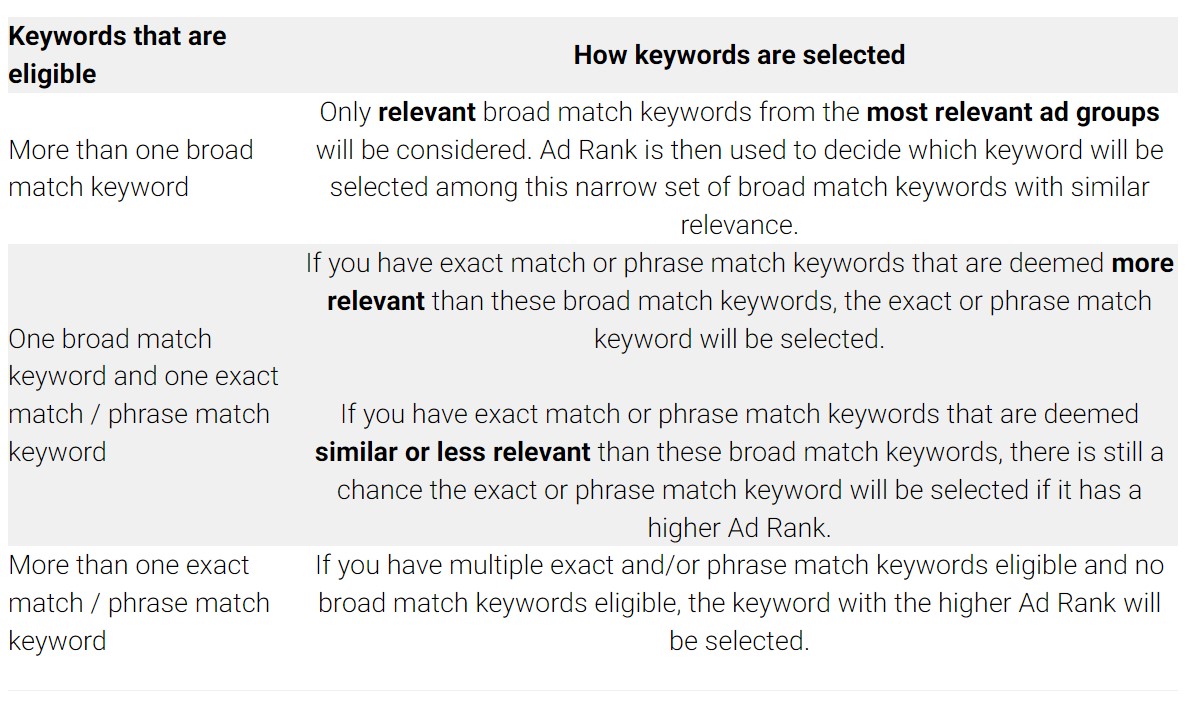Google Ads dropped two big announcements recently, including an update to how keywords match queries and a change to the default attribution model. Here’s what advertisers need to know about these updates.
Keyword prioritization rules are changing
Let’s break down Google’s latest announcement about keyword match types and see what it says:
With BERT, Google’s pre-training for natural language processing, getting more advanced, understanding search intent is now easier. Even broad match can now help you find relevant traffic with fewer keywords.
Google supported this with the example, “a highly specific query like ‘1995 5 speed transmission seal input shaft’ is now able to match with the broad match keyword ‘auto parts’ because we can tell they’re related, even though none of the words in the query and in the keyword actually match.”
A phrase match or broad match keyword identical to a query will now be preferred, as long as it is eligible to match.
Google has extended what it did with exact match earlier this year to broad and phrase match. Here’s Google’s example to explain this: “let’s say someone searches for ‘sushi delivery near me,’ and you have the broad match keywords ‘sushi delivery’ and ‘sushi delivery near me’. Before this update, both of these keywords would be eligible to serve. Now, the keyword ‘sushi delivery near me’ is preferred because it is identical to the search term.”
Rest easy though. Google goes on to say “that if you have an eligible exact match keyword that is identical to the query, it will still be preferred over the phrase and broad match keyword.”
Relevancy and Ad Rank will be the deciding factors when a search isn’t identical to any of your keywords.
In addition to Ad Rank, Google will now consider relevancy signals when determining which keyword will be selected. Explaining what these relevancy signals are, Google said, “Relevance is determined by looking at the meaning of the search term, the meaning of all the keywords in the ad group, and the landing pages within the ad group.” The different scenarios were broken down in the following table.

As with most significant announcements by Google, this one was also met with mixed responses from the PPC industry.
Julie Bacchini wrote: “So what exactly have you been doing up until now? Seriously. Was it foolish as an advertiser to think that was what you’d always done?" Read her thoughts on this change on her blog.
Others like Amy Bishop and Greg Finn argued that there is still value in maintaining multiple match types for the same keyword despite Google’s push to get advertisers to switch to a combo of smart bidding + broad match.
Data-Driven is now the default attribution model
In a move away from last-click attribution, Google announced that data-driven attribution (DDA) will be the default attribution model for all new conversion actions, starting October 2021.
Google acknowledged that the last-click attribution model falls short of advertisers’ needs because it ignores all but the final search before a user converts. Until now, advertisers without enough conversion volume to qualify for data-driven attribution were advised to switch to a position based or a time-decay model.
Google addressed the minimum data requirements for using DDA and said, “we’re removing the data requirements and adding support for additional types of conversions. With these improvements, we’re also making data-driven attribution the default attribution model for all new conversion actions in Google Ads.”
How is data-driven attribution better?
Let’s take an example of a user looking for running shoes. This user goes through several different searches before she converts. She might start with searches for ‘sneakers’ or ‘running shoes’, and after discovering Adidas’ line of running shoes, do another search for a specific model in her favorite color and size, and buy the shoes.
The problem with last-click attribution is that it gives all the credit to the last click. It’s going to ignore the fact that the user engaged with several of your ads; it’s going to ignore the fact that she got to the final keyword because she was exposed to upper-funnel keywords first. All these different keywords that the user searched for before converting are completely ignored.
Data-driven gives you a better picture of the entire purchase journey. Google now looks at the sequence of searches and sees how an individual query fits into that sequence. It estimates each keyword’s contribution to the eventual conversion. The following illustration from Google’s DDA methodology whitepaper shows how a particular query could be weighed.

Ultimately, data-driven attribution helps you better understand the value of all your keywords. With that improved knowledge, your manual and automated optimizations can get better. For example, when you find a non-converting search term, you might add it as a negative keyword, decide not to bid on it at all, or bid less. If you did this based on incomplete conversion data, like with data you’d get from LCA, you could hurt the performance of an account. Thanks to DDA, you can make better optimizations.
No attribution model will give you 100% accurate information, but data-driven comes closest to giving you the information that’ll allow you to reduce wasteful spending.
Finally, encouraging advertisers to combine data-driven attribution with automated bidding, Google said, “ When combined with automated bidding strategies, data-driven attribution can drive additional conversions at the same cost-per-acquisition. This is because our systems can better predict the incremental impact a specific ad will have on driving a conversion and adjust bids accordingly to maximize your ROI.”
If you don’t already know the perils of combining Smart Bidding and last-click attribution, you can read about it here.
Image Copyright PixieMe - stock.adobe.com










